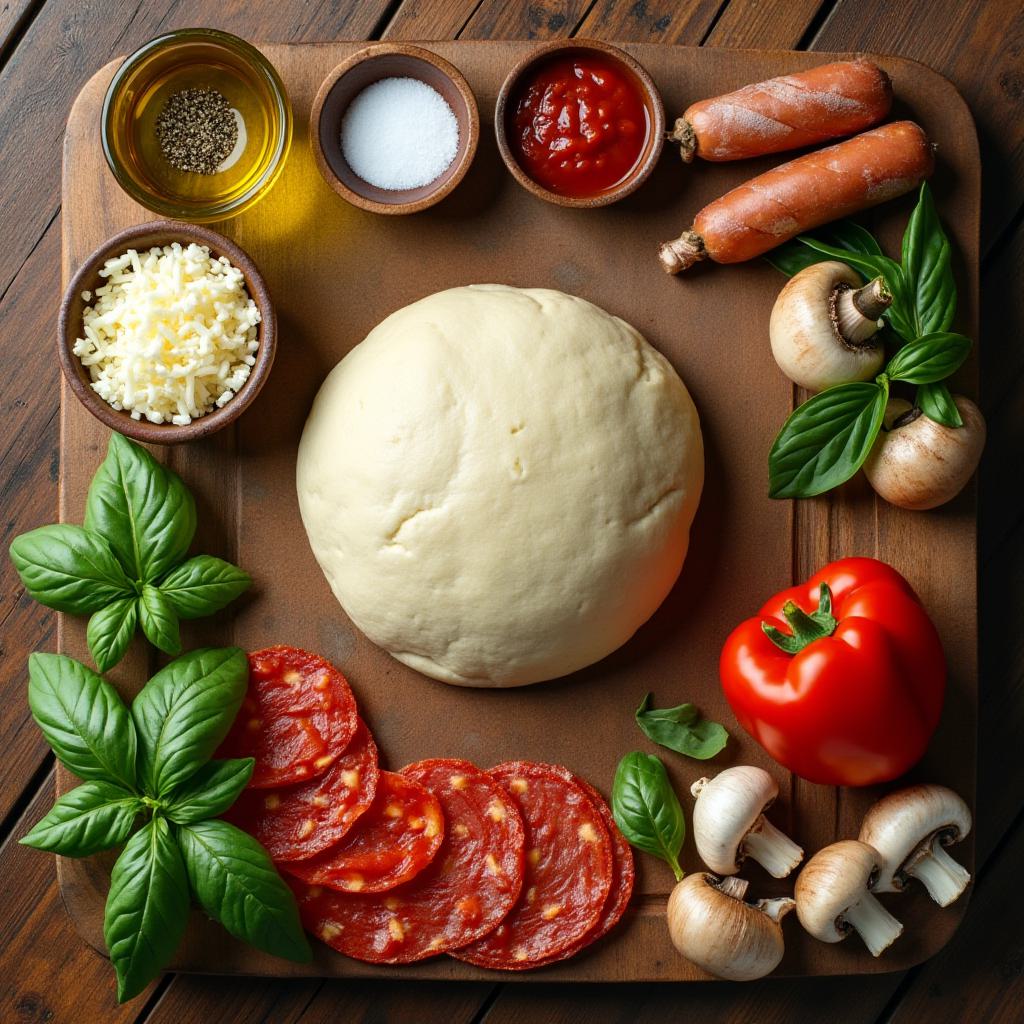Jump to Recipe
Ever wondered which Italian delight reigns supreme: the calzone or the pizza? This delicious debate isn’t just for food lovers but anyone passionate about Italian cuisine. Dive into this culinary comparison of ‘Calzone vs Pizza’ to find out why these stuffed pizza and traditional pizza rivals have enamored epicureans for centuries.
As we unravel the rich tapestry of their history, distinct preparation techniques, and irresistible flavors, you’re in for a treat that celebrates the best of both worlds.
Let’s embark on this mouthwatering journey together and see what makes each dish uniquely crave-worthy.
The Origins of Calzone and Pizza
The delightful journey of ‘Calzone vs Pizza’ starts deep in the heart of Italy. Both these staples of Neapolitan cuisine have fascinating backstories that make them culinary treasures.
Historical Background
Pizza, beloved by millions, has its origins in the bustling streets of Naples. It began as an affordable meal for the working-class, evolving from simple flatbreads topped with modest ingredients. On the other hand, calzone, which translates to ‘pant leg’ from Italian, emerged as a portable, hearty meal for laborers. Its convenient shape made it the perfect Italian street food for workers on the go.
Regional Differences in Italy
The diversity within southern Italian specialties is immense, and this is reflected in how different regions prepare their calzones and pizzas. In certain parts, calzones are commonly deep-fried, yielding a crispy exterior.
Conversely, pizzas can dramatically differ from one place to another: from the thin and crispy Roman versions to the soft and thicker Neapolitan base that captures the very essence of pizza history. Such variety showcases the richness of Italy’s culinary landscape.
Ingredients and Preparation Techniques
When it comes to calzones vs pizzas, the foundation begins with an excellent pizza dough recipe. Made from flour, yeast, water, salt, and olive oil, it forms the base for both dishes. How we knead and proof the dough directly impacts the texture and outcome.
Dough and Crust
The dough’s kneading and proofing play crucial roles. For both pizza and calzone, a well-kneaded dough ensures a chewy yet crisp texture. Proofreading gives it the perfect rise. The crust needs just the right balance of softness and crunch.
Using varied cooking methods, like baking on a stone or a metal tray, achieves different textures. Regardless of the approach, the results should always be delicious.
Filling and Toppings
The choices for fillings and toppings truly define the dish. For calzones, fillings often include combinations like mozzarella, ricotta, and Italian meats. This stuffing encases beautifully inside a folded dough.
Pizzas, on the other hand, showcase gourmet toppings such as pepperoni, mushrooms, and a variety of vegetables. The blend of authentic Italian cheese with these toppings makes each slice unique. The way we layer these ingredients massively impacts the flavor profile.
Both dishes benefit from the use of aromatic herbs. Basil, oregano, and thyme add the perfect finishing touches. Whether you’re crafting a pizza or folding a calzone, the process and ingredients create a memorable culinary experience.

Calzone vs Pizza: The Key Differences
When we think about calzones vs pizzas, the first thing that stands out is their shape and structure. Both offer unique dining experiences that can cater to different tastes and preferences.
Shape and Structure
Calzones are known for their distinctive crescent shape. This folded pizza delights with a perfectly sealed outer crust, keeping its rich fillings intact. In contrast, pizza’s open-faced, circular design offers an inviting display of toppings.
This fundamental difference defines the base aesthetic and eating experience with each dish.
Culinary Experience
Pizzas are par excellence for their variety. Each slice can carry a different topping, making every bite a new adventure. On the other hand, calzones provide a more personalized pizza experience.
Each bite of a calzone reveals a harmonious blend of its ingredients, making it perfect for savoring each exquisite flavor together.
Serving Styles
When it comes to serving, pizzas are often ideal for family-style dining. A large pizza brings everyone to the table, offering individual servings that can be easily shared. Calzones, however, lean towards a solo experience.
They’re a delight in individual servings, making them perfect for a quick meal or a personal indulgence when you’re on the go.
Taste Profiles and Flavor Experiences
In the ‘Calzone vs Pizza‘ debate, the taste profile of a calzone tends to be more robust and concentrated. Its enclosed structure keeps the Italian flavors and moisture locked in. When you bite into a calzone, the savory fillings burst forth, offering an intense taste sensation that’s tough to beat.
On the other hand, artisan pizza offers a unique experience. Each topping can shine independently, creating a varied and delightful flavor journey. From the classic Margherita to gourmet creations adorned with exotic vegetables and charcuterie, pizza caters to diverse palates and preferences.
Both calzone and pizza can be tailored to suit any taste. While calzone offers a rich, cohesive flavor due to its sealed nature, pizza dazzles with its range of individual tastes.
Whether you prefer the concentrated Italian flavors of a calzone or the individual notes of an artisan pizza, the taste sensation from both is unforgettable.
Health and Nutritional Comparison
When comparing the health aspects of calzone vs pizza, it’s essential to look at their caloric content and nutritional benefits. Let’s explore these to find out which holds the edge in healthy Italian food.
Caloric Content
Calzones are often richer in calories due to their cheesy filling and sometimes deep-fried crust. They can be bulkier, leading to an increase in energy intake. In contrast, a low-calorie pizza can be crafted using controlled portions of cheese and toppings, making it a better fit for diet-friendly options.
Nutritional Benefits
Both calzone and pizza can be part of balanced meals when you choose ingredients thoughtfully. Opt for whole-grain crusts, load up on vegetables, and keep an eye on portion sizes.
By doing so, these Italian delights can remain diet-friendly options while still providing a satisfying dining experience.
Popularity and Cultural Significance in the U.S.
Calzones and pizzas have both carved out significant niches within American food culture. Their unique flavors and satisfying characteristics make them favorites across various demographics.
Calzone in American Cuisine
Calzones have found their niche in American cuisine, shining brightly in Italian-American food culture. Their adaptable nature has made them popular among various American pizza variations and beyond.
In popular American eateries, calzones often feature local ingredients, enhancing their appeal. These folded delights offer a perfect blend of tradition and innovation, catering to those craving comfort food with a twist.
Pizza’s U.S. Domination
Pizza, on the other hand, reigns supreme as one of the nation’s most beloved comfort foods. Its widespread popularity is evident in the diverse American pizza variations available.
From the iconic New York slice to the hearty, deep-dish Chicago style, pizza is embedded in the fabric of American food culture. Popular American eateries across the country serve up these variations, making pizza a symbol of culinary creativity and universal appeal.
Both calzones and pizzas are integral to Italian-American food culture, each bringing joy and satisfaction to the American palate. Whether it’s a piping-hot calzone or a classic slice of pizza, these dishes continue to delight and comfort countless Americans.

Calzone vs Pizza
Ingredients
Method
- Dough Preparation:
- In a bowl, dissolve yeast and sugar in warm water. Let it sit for 5-10 minutes until foamy.
- Mix in flour, salt, and olive oil. Knead the dough until smooth and elastic, about 10 minutes.
- Cover the dough and let it rise in a warm place for about 1 hour, or until doubled in size.
- For Calzone:
- Preheat your oven to 475°F (245°C).
- Divide the dough in half. Roll out one half into a circle about ¼ inch thick.
- Spread ricotta, mozzarella, sausage, and mushrooms over half of the dough, leaving a border.
- Fold the dough over the filling to create a half-moon shape. Press the edges to seal.
- Transfer the calzone to a baking sheet lined with parchment paper.
- Bake for 15-18 minutes, until golden brown and puffed.
- For Pizza:
- Preheat your oven to 475°F (245°C) and place a pizza stone or baking sheet inside to heat.
- Roll out the remaining dough half into a circle about ¼ inch thick.
- Spread tomato sauce evenly over the dough, leaving a small border for the crust.
- Sprinkle mozzarella cheese and your favorite toppings.
- Transfer the pizza to the hot stone or baking sheet and bake for 12-15 minutes until the crust is golden and the cheese is bubbly.
Notes
You can customize both the calzone and pizza with your favorite fillings and toppings.
The dough can be made ahead and stored in the fridge for up to 24 hours.
Conclusion
As we reach the end of this delectable exploration, it’s clear that the pizza vs calzone debate is closer to an art form than a science. Both dishes, with their rich history and culinary significance, hold a special place in the hearts of food enthusiasts’ favorite picks.
They each offer unique Italian cooking inspiration that can be tailored to your taste.
From the carefully crafted dough to the delightful toppings and fillings, these classics provide endless opportunities for culinary creativity. Whether you prefer the stuffed, portable nature of a calzone or the open, versatile appeal of a pizza, there’s no wrong choice.
So, immerse yourself in the kitchen and whip up your version of these legendary dishes. The best judge in the pizza or calzone debate is, after all, your own taste buds. Embrace the joy of cooking, and let your palate guide you through this endless journey of flavors. Click here for more homemade pizza recipes. Happy cooking!
